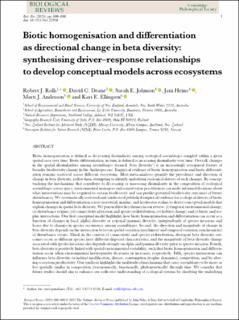| dc.description.abstract | Biotic homogenisation is defined as decreasing dissimilarity among ecological assemblages sampled within a given spatial area over time. Biotic differentiation, in turn, is defined as increasing dissimilarity over time. Overall, changes in the spatial dissimilarities among assemblages (termed ‘beta diversity’) is an increasingly recognised feature of broader biodiversity change in the Anthropocene. Empirical evidence of biotic homogenisation and biotic differentiation remains scattered across different ecosystems. Most meta-analyses quantify the prevalence and direction of change in beta diversity, rather than attempting to identify underlying ecological drivers of such changes. By conceptualising the mechanisms that contribute to decreasing or increasing dissimilarity in the composition of ecological assemblages across space, environmental managers and conservation practitioners can make informed decisions about what interventions may be required to sustain biodiversity and can predict potential biodiversity outcomes of future disturbances. We systematically reviewed and synthesised published empirical evidence for ecological drivers of biotic homogenisation and differentiation across terrestrial, marine, and freshwater realms to derive conceptual models that explain changes in spatial beta diversity. We pursued five key themes in our review: (i) temporal environmental change; (ii) disturbance regime; (iii) connectivity alteration and species redistribution; (iv) habitat change; and (v) biotic and trophic interactions. Our first conceptual model highlights how biotic homogenisation and differentiation can occur as a function of changes in local (alpha) diversity or regional (gamma) diversity, independently of species invasions and losses due to changes in species occurrence among assemblages. Second, the direction and magnitude of change in beta diversity depends on the interaction between spatial variation (patchiness) and temporal variation (synchronicity) of disturbance events. Third, in the context of connectivity and species redistribution, divergent beta diversity outcomes occur as different species have different dispersal characteristics, and the magnitude of beta diversity change associated with species invasions also depends strongly on alpha and gamma diversity prior to species invasion. Fourth, beta diversity is positively linked with spatial environmental variability, such that biotic homogenisation and differentiation occur when environmental heterogeneity decreases or increases, respectively. Fifth, species interactions can influence beta diversity via habitat modification, disease, consumption (trophic dynamics), competition, and by altering ecosystem productivity. Our synthesis highlights the multitude of mechanisms that cause assemblages to be more or less spatially similar in composition (taxonomically, functionally, phylogenetically) through time. We consider that future studies should aim to enhance our collective understanding of ecological systems by clarifying the underlying mechanisms driving homogenisation or differentiation, rather than focusing only on reporting the prevalence and direction of change in beta diversity, per se. biodiversity, beta diversity, biotic homogenisation, biotic differentiation, species assemblage, turnover | en_US |

